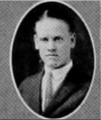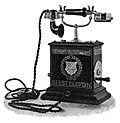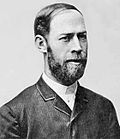Portal:Telecommunication
The Telecommunication Portal

Telecommunication, often used in its plural form or abbreviated as telecom, is the transmission of information over a distance using electronic means, typically through cables, radio waves, or other communication technologies. These means of transmission may be divided into communication channels for multiplexing, allowing for a single medium to transmit several concurrent communication sessions. Long-distance technologies invented during the 20th and 21st centuries generally use electric power, and include the telegraph, telephone, television, and radio.
Early telecommunication networks used metal wires as the medium for transmitting signals. These networks were used for telegraphy and telephony for many decades. In the first decade of the 20th century, a revolution in wireless communication began with breakthroughs including those made in radio communications by Guglielmo Marconi, who won the 1909 Nobel Prize in Physics. Other early pioneers in electrical and electronic telecommunications include co-inventors of the telegraph Charles Wheatstone and Samuel Morse, numerous inventors and developers of the telephone including Antonio Meucci, Philipp Reis, Elisha Gray and Alexander Graham Bell, inventors of radio Edwin Armstrong and Lee de Forest, as well as inventors of television like Vladimir K. Zworykin, John Logie Baird and Philo Farnsworth.
Since the 1960s, the proliferation of digital technologies has meant that voice communications have gradually been supplemented by data. The physical limitations of metallic media prompted the development of optical fibre. The Internet, a technology independent of any given medium, has provided global access to services for individual users and further reduced location and time limitations on communications. (Full article...)
Selected article -

In telecommunications, orthogonal frequency-division multiplexing (OFDM) is a type of digital transmission used in digital modulation for encoding digital (binary) data on multiple carrier frequencies. OFDM has developed into a popular scheme for wideband digital communication, used in applications such as digital television and audio broadcasting, DSL internet access, wireless networks, power line networks, and 4G/5G mobile communications.
OFDM is a frequency-division multiplexing (FDM) scheme that was introduced by Robert W. Chang of Bell Labs in 1966. In OFDM, the incoming bitstream representing the data to be sent is divided into multiple streams. Multiple closely spaced orthogonal subcarrier signals with overlapping spectra are transmitted, with each carrier modulated with bits from the incoming stream so multiple bits are being transmitted in parallel. Demodulation is based on fast Fourier transform algorithms. OFDM was improved by Weinstein and Ebert in 1971 with the introduction of a guard interval, providing better orthogonality in transmission channels affected by multipath propagation. Each subcarrier (signal) is modulated with a conventional modulation scheme (such as quadrature amplitude modulation or phase-shift keying) at a low symbol rate. This maintains total data rates similar to conventional single-carrier modulation schemes in the same bandwidth. (Full article...)
General images
Things to do
 |
Here are some tasks awaiting attention:
|
Selected biography -
Philo Taylor Farnsworth (August 19, 1906 – March 11, 1971) was an American inventor and television pioneer. He made the critical contributions to electronic television that made possible modern electronic video. He is best known for his 1927 invention of the first fully functional all-electronic image pickup device (video camera tube), the image dissector, as well as the first fully functional and complete all-electronic television system. Farnsworth developed a television system complete with receiver and camera—which he produced commercially through the Farnsworth Television and Radio Corporation from 1938 to 1951, in Fort Wayne, Indiana.
In later life, Farnsworth invented a small nuclear fusion device, the Farnsworth Fusor, employing inertial electrostatic confinement (IEC). Like many fusion devices, it was not a practical device for generating nuclear power, although it provides a viable source of neutrons. The design of this device has been the inspiration for other fusion approaches, including the Polywell reactor concept. Farnsworth held 300 patents, mostly in radio and television. (Full article...)
Did you know (auto-generated) -

- ... that actor Tatsunari Kimura ate pancakes and drank coffee while talking for eight hours during the filming of the television drama Old-Fashioned Cupcake?
- ... that the hashtag #AlDubEBTamangPanahon set a Guinness World Record in 2015 with 40,706,392 uses in 24 hours, coinciding with the television event "Tamang Panahon"?
- ... that Sunday-school classes were once held in the transmitter building of New Mexico radio station KCLV?
- ... that a woman hitchhiked from Indiana to Washington, D.C., to protest the sale of the radio station where she worked?
- ... that 1920s and 1930s radio show actress Artie Belle McGinty played the original radio advertisement voice for Aunt Jemima?
- ... that the church that attempted to sell a Kansas radio station could not locate the money allegedly paid by the buyer?
Related portals
Topics
Subcategories
Associated Wikimedia
The following Wikimedia Foundation sister projects provide more on this subject:
-
Commons
Free media repository -
Wikibooks
Free textbooks and manuals -
Wikidata
Free knowledge base -
Wikinews
Free-content news -
Wikiquote
Collection of quotations -
Wikisource
Free-content library -
Wikiversity
Free learning tools -
Wiktionary
Dictionary and thesaurus
































































































